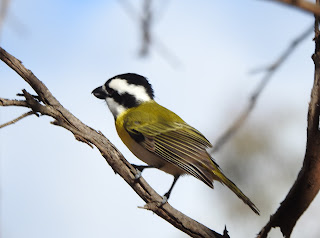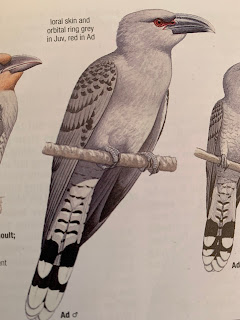Monday, 30 December 2024
BIRD OF THE MONTH 2024
My awards for the Bird of the Month 2024 are as follows:
JANUARY: TAWNY FROGMOUTH:
I've always loved Tawny Frogmouths and I try to get them onto my birdlist every month. I have a couple of local spots I check every month, but if these birds let me down, I go to Blackburn, where I'm usually successful, or Royal Park. This photo was taken in Royal Park by Peter Petinatus.
FEBRUARY: RED KNOT:
The Red Knot is not a rare bird, but it is one I don't often see. In February I saw them at Werribee, hence it became the Bird of the Month. This beautiful photo is by David Hollands. I took it from 'Waders, The Shorebirds of Australia' by David Hollands and Clive Minton. The Red Knots really stand out. The ones I saw at Werribee were not in breeding plumage, and did not stand out. They melted into the background of other anonymous waders. The photo also shows Grey-tailed Tattlers, Sand Plovers and Curlew Sandpipers.
MARCH: MANGROVE GERYGONE:
I saw this bird at Wynnum Mangrove Boardwalk in Brisbane, where Rae Clark took me birding. (Thank you, Rae!) Although it is not rare, it is a bird I do not see every year and it is a dear little thing, I'm sure you'll agree. I sometimes think it has been mis-named: I don't see them in Mangroves. I see them in paperbarks, adjacent to Mangroves. This photo is Peter Marsack's illustration in the Australian Bird Guide.
APRIL: WESTERN SHRIKETIT:
My first lifer for the year. I put in some effort for this bird, then, when I saw it, it couldn't have been easier. It was at the traditional spot, by the water feature at the Stirling Range Retreat, right on cue. I had looked for it on a previous visit to Western Australia, and failed, so this was a special trip to the other side of the continent. And well worth it too. I don't think the Western Shriketit is as pretty as our Eastern one, but a tick's a tick in anyone's language. Des Hume showed me this bird and took this photo. Thank you, Des.
MAY: HOODED ROBIN:
Hooded Robins bred every year on my parents' property in north-central Victoria. I was with my parents the day they decided to buy the property, and I reckon it was a Hooded Robin that clinched the deal! I love all those birds of the box/ironbark countryside. Hooded Robins in particular always remind me of my parents' place. In May, I saw them in the Warby Ranges, on my way to check out the birds of Chiltern. Again, I took this illustraion from the Australian Bird Guide. It is another of Peter Marsack's lovely images.
JUNE: SANDHILL GRASSWREN:
I saw this bird in June, but it was not split by the IOC until July. Louis Masarei showed it to me at Sandstone in WA. I have been unable to find an illustration of it.
JULY: SUPERB LYREBIRD:
My birdy friend, Helen Yuille, wanted to see a lyrebird. With great confidence, I said I'd show her one. Of course I'd seen them countless times. And I reckon I could find one easily enough in far east Gippsland. But where could I guarantee to find one a short drive from of Melbourne? I thought perhaps Healesville, but (after consulting some people who know a lot more than me) decided on Sherbrooke. Helen and I found the recommended track and heard lyrebirds almost immediately. Then we saw them: I think we saw three altogether, but one bird in particular put on an impressive display. Mission accomplished!
AUGUST: TIBETAN SAND PLOVER:
In August I had my third trip to Western Australia in 2024 and my third lifer for the year. I got this bird thanks to Louis Masarei. Thank you, Louis. I saw them again on Cocos (South Island, on the Saunders's Tern hunt), but it wasn't nearly as exciting as making a special trip to Broome for the tick. This photo was taken on Cocos by Richard Baxter. The Tibetan Sand Plover is the bird on the left.
SEPTEMBER: OLIVE WHISTLER:
I visited Tasmania in September with my birding mate, Ken Haines, with the sole purpose of going on a pelagic. The pelagic was cancelled and so we made do with a little Tasmanian birding. It was very windy, (guess why the pelagic was cancelled!) and the birds refused to cooperate. However, a couple of Olive Whistlers put on quite a show for us. I enjoyed it very much. I'm not sure I'd say it made the trip to Tasmania worthwhile, but it was certainly fun. Ken took this photo.
OCTOBER: CHANNEL-BILLED CUCKOO:
These extraordinary birds look like they were created by a committee. I don't see them often and they never fail to create quite an impression. Ironically, these birds flew over as I set off on a pelagic out of Kiama. I would have expected my bird of the day (let alone my bird of the month) to be a seabird. But this flock of cuckoos, calling as they flew, were certainly worthy of the accolade. Again, this illustration is from the Australian Bird Guide. This time it is by Jeff Davies.
NOVEMBER: KAMKATCHA LEAF WARBLER (sometimes called simply Kamkatcha Warblers):
In November, I visited Ashmore Reef for the third time. All I wanted to see was a Nazca Booby. Of course I knew that the chances were extremely slim, but I had to try, didn't I? And of course I didn't see any Nazca Boobies. However, on Browse Island, on the way home, we found a pair of warblers. Initially we thought they were Arctic Warblers, but a sonogram of their call identified them as Kamkatcha Leaf Warblers. Again, this illustration is from the Australian Bird Guide, another of Peter Marsack's little gems. They are in fact identical to Arctic Warblers. Without Louis, we would never have known what they were.
DECEMBER: BLACK-NAPED ORIOLE:
How could I possibly go past this gorgeous bird for my bird of the month for December? Not only was it gob-smackingly gorgeous, it was my 850th bird. And exceptionally rare. I believe this was the second record for Australia. I saw it in the Big House garden on Home Island in the Cocos group. And I only saw it thanks to Sue Abbotts. Thank you, Sue! This photo is by Nick Thompson. Thank you, Nick!
Not a bad year, I'm sure you'll agree. To get ten lifers in a year is pretty good, I think. I won't do that again in a hurry. But I can't help wondering, what exciting birds will 2025 offer me?
Subscribe to:
Post Comments (Atom)












No comments:
Post a Comment